"Most Arrows": Autonomy and Intertextuality in Emily Dickinson's Late Fragments
The best company for me is she or he who is in touch with the instant, in writing. . . . A bird-catcher of instants. —Hélène Cixous
Two passageways, two invitations, open within Dickinson's late work. The first extends from Dickinson to a sometimes named, sometimes anonymous, outside reader; the second stretches from a questioning alterity back to the writer who, in trying to meet it, bypasses the reader and the established codes of communication and returns to a luminous yet illegible form of private notation. The letters and poem-messages of the 1870s and 1880s, although already marked by a fanning out of specific address that has often been mistaken for clairvoyance, are still legible; they may be intercepted, even answered, by a vanishing reader. The fragments, on the other hand, a mob of traces, some in verse, others in prose, if we prefer a distinction that is by this time in extremis, belong to the pre-scriptive processes of thought or, rather, since these are "retrieveless," to that moment when the words that lie in wait for thoughts suddenly ambush them, tracing a path for them in a writing that briefly keeps pace with thinking—perhaps even outstrips it. ✝ The word "retrieveless" is Dickinson's. Her first recorded use of it is in fascicle 25 (1862) in the poem beginning "I tried to think a lonelier | thing." It appears in two other poems: "It bloomed and dropt, | a Single Noon -" and "The Frost was | never seen -." Together and separately they inaugurate a lyric nondiscourse scattered in an infinity of singular articulations and manifested finally as an absence d'oeuvre. Untitled, unauthorized, and extrageneric, these whispers at the outer limits of Dickinson's work ask "Where do I exit and go and how do I proceed?" ✝ The question is Novalis's and, more generally, that of the Jena Romantics. Yet it is also, if obliquely, the question posed by Dickinson's late writings.
A reader enters the scene of composition long after the author's departure. Dickinson's writing table, a small mahogany desk eighteen inches square with a single drawer just deep enough for ink pots and stationery, stands cleared of unruly remains, exorcised of ambiguities. It appears before us like a blank page. Yet Dickinson's manuscripts, the material witnesses of her late aesthetic itinerary, offer striking testimony about the spectacular turbulence and commotion—the pandemonium—that attended the act of composition. In some cases it appears that a fragment of text was composed on an already torn scrap of paper drawn up or beyond its original use at the moment of inspiration; in other cases Dickinson seems to have begun by composing a block of lines on a sheet of paper and then cut or torn most of the sheet away. Later, several random lines saved for years might be pinned together, re-associated along the lines of rhyme or theme. Millicent Todd Bingham, whose privilege was never to see Dickinson while she was alive, left this beautiful, accurate description of her late textual body:
When first discovered [the manuscripts] looked impossible—a jumble of words on odds and ends of paper, some of it crumpled or torn. . . . There are pink scraps, blue and yellow scraps . . . all . . . written in pencil and all in the late handwriting. . . . The strokes are sometimes faint and the lines often overlap so that the words overtake one another as if written in the dark. Indeed, some thoughts are potent enough to have roused her from sleep. ✝ Millicent Todd Bingham, "Prose Fragments of Emily Dickinson," New England Quarterly 28 (September 1955): 293; and "Introduction," Bolts of Melody, edited by Mabel Loomis Todd and Millicent Todd Bingham (New York: Harper, 1945), xv.
Today the manuscripts of more than one hundred of the late fragments are stored in the vault of the Amherst College Library, Special Collections. The silent interior of an interior, a complex of protected spaces, the archive would have fascinated Dickinson. Founded on the twinned ideas of memory and order, on the one hand, the archive offers, on the other, a shifting collection of pieces out of place, the remains of a heterogeneous estate that resist reintegration into any single, perfect order. In the archive even the most fragile, secret, or disconcerting elements of a writer's activity are carefully preserved. Here, where the present is suspended, the reader is projected into another time, another place. The questions that draw me into the archive also (with)draw me into the rifts between history and memory, authorial intention and textual revelation . . .
I open a box filled with fragments, "lost events." Inside folders, pressed between leaves, I find perfect quatrains beside barely legible lists of words held together with straight pins . . . I am under the spell of traces, strange comminglings . . .
With two clearly identified exceptions, the fragments that have survived amid so many hazards and losses were composed in the 1870s and 1880s. ✝ The two surviving fragments that may have been composed in the 1850s and 1860s are "With the sincere spite of a Woman." and "I send a Violet for Libby." Both are in ink, and the handwriting places them among Dickinson's early writings. Millicent Todd Bingham suggests that both messages were mailed but later somehow found their way back into Dickinson's papers. According to David Higgins, however, repeated phrases and sentences in compositions written in the mid-1850s suggest that an earlier collection of fragments, no longer extant, once existed. ✝ See David Higgins, "Introduction: Emily Dickinson's Prose," in A Portrait of Emily Dickinson: The Poet and Her Prose (New Brunswick: Rutgers UP, 1967), 3–24. Higgins's Portrait is the only full-length study of Dickinson's prose available. If Higgins's hypothesis is correct, then two groups of fragments, composed twenty years apart, mark the boundaries of Dickinson's high poetic style as well as the boundaries of the forty manuscript volumes, the first of which appears quite suddenly around 1858 and the last of which was completed less than ten years later, in 1866, when Dickinson closed the doors of her private bindery forever. ✝ I am grateful to Ellen Hart for her suggestion of the term "manuscript volumes" to describe Dickinson's bound groups of poems, and I have substituted the term "manuscript volume" for the more commonly used "fascicle" and "packet" throughout. As Hart pointed out to me in conversation, the terms "fascicle" and "packet" were not, after all, Dickinson's, but her editors. Moreover, Dickinson's editors do not always use the terms "fascicle" and "packet" consistently: at times, the terms "fascicle" or "packet" are applied to groups of poems stab-bound by Dickinson; at times to the groups of poems held together with brass fasteners; and, at still other times, to loose sheets apparently sorted into groups for binding. Here the term "manuscript volume" refers exclusively to groups of poems stab-bound and tied together, or to groups of poems held together with brass fasteners. Although Dickinson's practice in the late 1850s and early 1860s of transcribing and binding final and semifinal drafts of her poems into manuscript volumes—at which time she presumably jettisoned rough drafts—makes it impossible to establish a definitive chronology of composition, it is nonetheless clear that during these years the onrush of vision was almost alarming. In the annus mirabilis of 1863, Dickinson composed or at least copied no less than 366 poems into manuscript volumes—almost one quarter of her extant oeuvre. "Her creative energies," wrote Thomas Johnson, "were at flood, and she was being overwhelmed by forces which she could not control." ✝ Thomas H. Johnson, "Creating the Poems," in The Poems of Emily Dickinson. 3 vols. (Cambridge, Mass.: The Belknap P of Harvard UP, 1955), xviii. See R. W. Franklin's introduction (The Poems of Emily Dickinson. Variorum ed. 3 vols. Cambridge, Mass.: The Belknap P of Harvard UP, 1998), where he contests the earlier theory that 1862 was Dickinson's watershed year for poetic production, and instead posits that the peak year was 1863. After 1870, the "crisis" over, Dickinson appears to enter a prolonged period of diminished or blocked productivity. In what would be the final phase of her work she continues to draft poems and messages, but she no longer copies them onto uniform sheets of paper or binds them into manuscript volumes, and the great majority remain in the worksheet stage. Fragments now proliferate. ✝ Dickinson scholars often use the terms "early," "middle," and "late" to refer to Dickinson's style periods. Yet so far there has been very little subtle analysis of the three style periods—the elements characteristic of each—and still less analysis of the causes for the transitions from one style period to another and of the dynamic interplay of early, middle, and late style elements in her poems and letters. In his foreword to The Poems of Emily Dickinson (Cambridge, Mass.: The Belknap P of Harvard UP, 1955) Thomas H. Johnson writes: "Emily Dickinson was born to her talent but she felt no dedication to her art until she was about twenty-eight years old, in 1858. By 1862 her creative impulse was at flood tide, and by 1865 the greater part of her poetic energies were spent. She continued to write poetry until her death in 1886, when she was fifty-five years old, and many of her later verses are among her great creations. But after 1870 her poems are relatively few in number and were often composed for an occasion and for the friends to whom they were sent." In "Creating the Poems," Johnson's introduction to the 1855 variorum, he adds, "Her interest in the packet method of assembling the verses . . . coincides with the years of fullest productivity." R. W. Franklin, in his introduction to The Manuscript Books of Emily Dickinson (Cambridge, Mass.: The Belknap P of Harvard UP, 1981), refines Johnson's periodization schema somewhat by including a more detailed portrait of Dickinson's patterns of copying and binding. Although he does not undertake a full analysis of the style elements in the bound poems or of the stylistic changes within the manuscript volumes, his work makes possible an particularly rich analysis of Dickinson's "middle" or "high" period. The full significance of even this major style period will not be grasped, however, until it is seen in relationship to the early and especially the late style periods.
So far, these fragments have been read as signs of the failure or, at the very least, the intermittency, of Dickinson's late vision. Yet, if the stockpiling of a (lost) group of fragments in the mid-1850s was preparatory to Dickinson's first major aesthetic and stylistic shift, her break into poetry and bookmaking, is it not also possible that the accumulation of a significant body of fragments in the 1870s and 1880s announces the onset of another, further stylistic crisis that has long gone unrecognized because its extremity has been alternately explained and overtaken by the biographical crisis of Dickinson's death in 1886? Rather than signifying the inevitable decline of creative energies, the late, extant collection of fragments may mark the moment when, having simultaneously reached the outermost boundaries of the prevailing style of the 1860s and the limits of the codex book, Dickinson was once again entering a transitional term of profound experimentation and instability. Here, outside the order of the manuscript volumes, and beyond the locus of power, ambition was redirected and writing—a writing beyond the ending—governed by a new "eros of inquiry." ✝ Jerome A. Miller, In the Throe of Wonder: Intimations of the Sacred in a Post-Modern World (Albany: State U of New York P, 1992), 176. Marked by their remarkable and unprecedented exploration of the dialectics of exile and joy, dispossession and delight, the fragments are en route to a place they will never arrive. Linked to what is in transit, disappearing, they resemble fingerprints, the light touches of the artist who, having submitted fully to the process of writing and constantly reaching new decisions, no longer thinks of finishing any particular text.
How can we retrace where they came from and in what direction they are traveling? If the metaphysician, in search of the distant eschaton, relies on his powers of farsightedness, the textual geneticist favors nearsightedness, covets closer, more intimate discoveries. Sifting through the masses of papers, studying fragments day after day, the details of paper and pencil seem to dilate before my eyes until the unreflective surface of the library desk becomes a mysterious light table.

Focus 1: A desk in the Dickinson household.
Even in the context of Dickinson's own oeuvre the fragments may at first seem sui generis, and their irregularity continues to be reflected in their bibliographical status as textual fugitives and as "luxuries in the field of knowledge," fascinating and yet dispensable. Mistakenly called "aphorisms" and "epigrams"—as if Dickinson's style (thought) had become terse, lapidary, and bounded instead of simply sudden, exorbitant in its artlessness and its claims to freedom—what these writings are remains radically undecidable: they may be passwords to unknown and still unwritten poems, codas to a lost vision, or singular transcriptions of the way in which Dickinson "heard" poetically. Composed in neither the past nor the future tense but in what might be called the process tense, many of them reveal the kinesthetics of writing-as-dictation, the inscription of energeia, in which the hand that has begun to move across the page is seized and directed by an unknown agency, an other who, as Dickinson wrote, "comes" and "over takes the mind" (A 879). Fragments, like glossolalia, "cross over the boundary lines of ordinary language," abolishing all bonds with the methods and measures of discourse: they write themselves. ✝ Paul Zumthor, "The Voice and the Text," New Literary History 16 (Autumn 1984): 75.

Focus 2: A 844. Last decade. Lines penciled on a strip (25 x 139 mm) of envelope (?).
Of the more than one hundred extant fragments I took as my point of departure, approximately half descend to us as exilic passages. In the more fully developed of these passages, Dickinson may be seen ranging freely about in the open spaces between or outside stanzas where writing becomes a form of radical essaying, a way of rigorously avoiding the limits of the mind. Here a writer's "exploration of scattered centers of thought" is graphically translated onto the paper's surface in the form of scribblings in the margins, cancelations, blocks of texts divided or connected with dashes, ellipses suggesting the momentary eclipse of inspiration or only language. ✝ Serge Tisseron, "All Writing Is Drawing: The Spatial Development of the Manuscript," Yale French Studies 84 (1994): 40. Here, at last, the extreme contraction characteristic of the earlier style periods is unworked in a language of pure hypothesis, in fragments upon which we have no purchase. Their subject appears to be some kind of transition—the approach of death, the break of day—whose accomplishment cannot be effected by reasoners, making their careful way from proof to proof, but is instead endlessly postponed in order to render permanent the experience of the threshold. This Dickinson, a post-poetical Dickinson whose late, acute investigations are pensées on the order of Pascal and Wittgenstein, passes by, still unmet a century after her death.
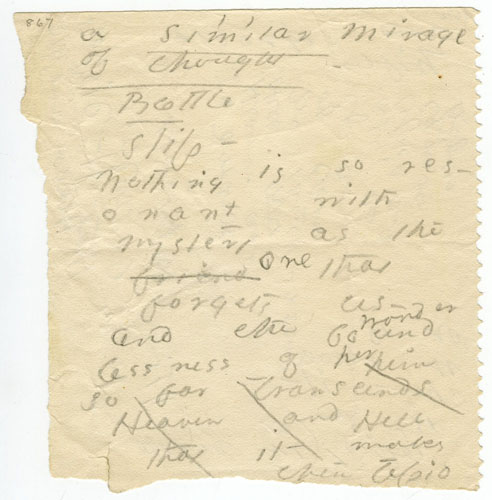
Focus 3: A 867. Last decade. Lines penciled on both sides of a torn and crumpled HENRY ADAMS PHARMACY wrapper (110 x 116 mm).
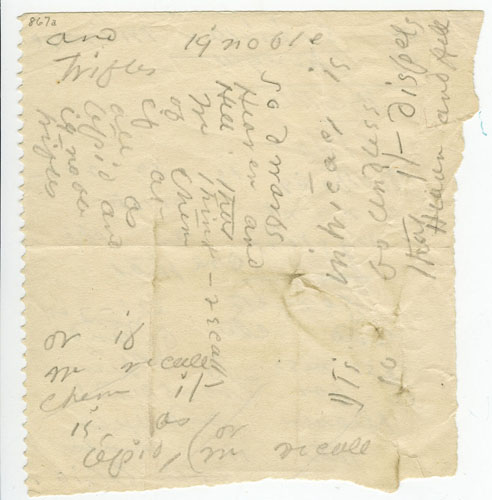
Focus 3a: A 867a.

Focus 4: A 871. Last decade. Lines penciled on both sides of a torn fragment (90 x 90 mm) of off-white wrapping paper.
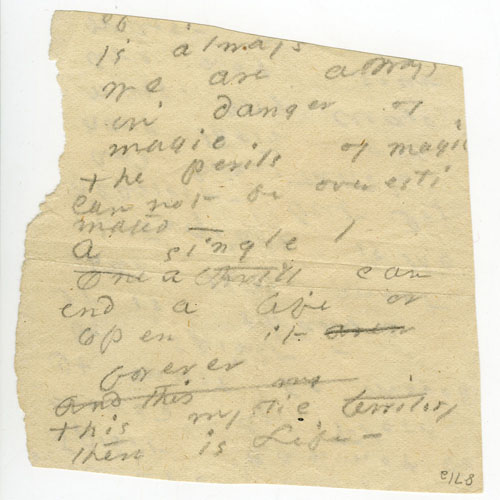
Focus 4a: A 871a.
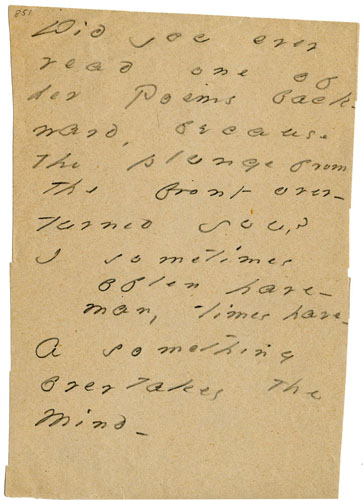
Focus 5: A 851. Last decade. Lines penciled on a fragment (163 x 117 mm) of brown wrapping paper.
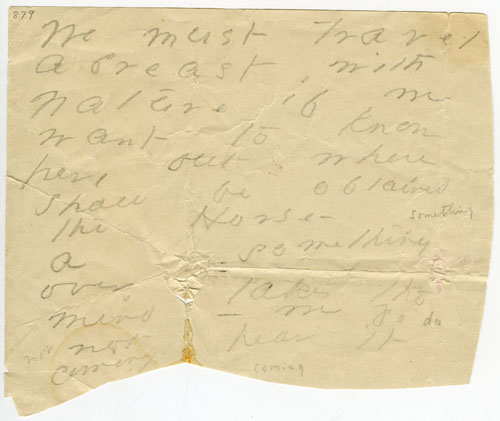
Focus 6: A 879. Last decade. Lines penciled on a creased fragment (125 x 145 mm) of off-white wrapping paper.
More common by far than the investigative passages cited here, however, are those fragments that descend to us like solitary outriders haunted by communion. Shimmering and brief, "eviscerated," as Emerson said, "of care," vulnerability is the mark of their existence. If they are the nuclei of poems or messages in a state of pure potentiality and in search of conditions yet to be defined, they are also often bolder than Dickinson's more finished texts. Like souls, neither touching nor mingling, never composing a set, these positionless fragments depict the beauties of transition and isolation at once. Belonging to a chronology of the instant, an edition of them would have to present them as a discontinuous series, a "book from which each page could be taken out." ✝ Hélène Cixous, "The Last Painting or Portrait of God," in "Coming to Writing" and Other Essays, edited by Deborah Jenson, with an introductory essay by Susan Rubin Suleiman (Cambridge, Mass.: Harvard UP, 1991), 105.
Here are several that arrive/return unaccompanied.

Focus 7: A 331. Last decade. Lines penciled on a scrap (34 x 126 mm) of laid, white stationery.
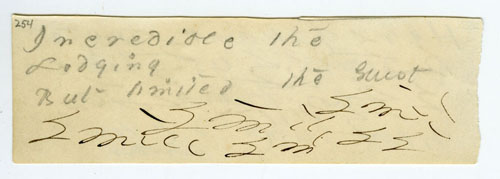
Focus 8: A 254. About 1877? Lines penciled amid pen tests on a scrap (30 x 94 mm) of wove, white stationery.
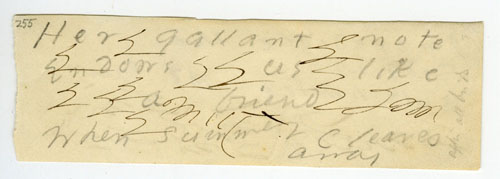
Focus 8a: A 255.

Focus 9: A 864. Last decade. Lines penciled on a narrow strip (24 x 126 mm) of laid, white stationery.
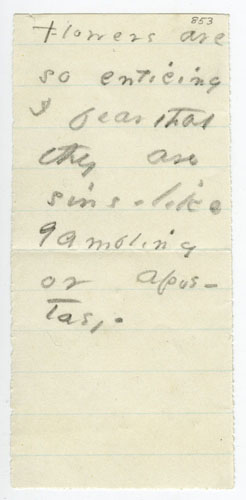
Focus 10: A 853. Last decade. Lines penciled on a scrap (95 x 44 mm) of wove, white, blue-ruled stationery.

Focus 11: A 875. Last decade. Lines penciled on a fragment (22 x 118 mm) of quadrille stationery.
Sometime in 1884 Dickinson wrote on a small slip of paper the words

and attached the slip to an unfinished draft of a message-poem (A 637) to Susan Dickinson composed on the anniversary of her youngest child's death. The slip repeated the first two words of the message's closing lines: "Most Arrows | slay but whom | they strike -."
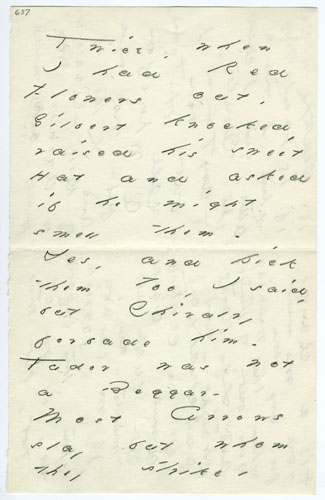
Sometime later, for reasons unknown, the slip was unpinned. Like this "arrow text" that both pierces and emanates from the heart of a heartbreaking message, many of the apparently autonomous fragments may have at one time been linked to other, still unidentified texts. And in some instances it is the "arrows," rather than the texts to which they were at one time linked, that have alone returned to us, sharp reminders that even a complete inventory of Dickinson's extant writings can never reveal how many more have been lost.
Today five lines, two on a scrap of WESTON'S LINEN and three on a tiny fragment of quadrille stationery, fleetingly rumor the existence of two poems almost certainly written by Dickinson in the 1870s but now surviving only in the transcripts made by Mabel Loomis Todd. Like the combinations of dots and dashes used in Morse code to convey messages in abbreviated form, these witnesses tap against the wall of Todd's transcriptions, revealing, perhaps, the somatic charge of the lost original.
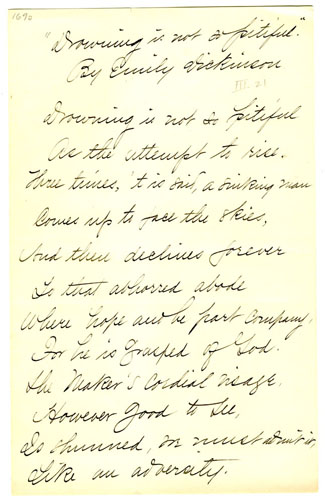
Focus 12: A 169a. Mabel Loomis Todd's transcript.
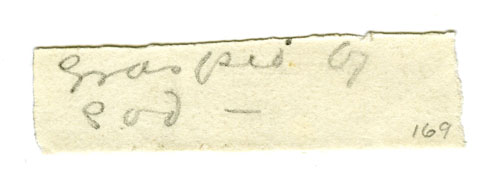
Focus 13: A 169. Dickinson's fragment. About 1880? Lines penciled on a scrap (10 x 41 mm) of wove, white stationery embossed WESTON'S LINEN.
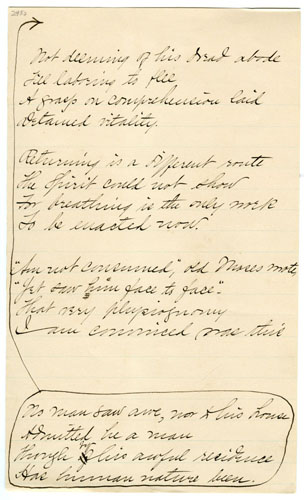
Focus 14: A 295a. Mabel Loomis Todd's transcript.

Focus 15: A 295. Dickinson's fragment. About 1874? Lines penciled on a scrap (29 x 128 mm) of quadrille stationery.
Finally, within the constellation of Dickinson's late writings are those fragments that are the augurers of more complete and present texts. Again and again, as if poems, letters, and fragments communicated with one another telepathically, a line or phrase from a fragment may reappear, often in a slightly altered form, in the body of a poem, a message, or even another fragment. In 1955, when Millicent Todd Bingham first printed a selection of Dickinson's fragments in the New England Quarterly, she cautioned: "To trace the course of an idea from seed to flower, whether blossoming in a poem or a letter to a friend, would be a devious but enlightening study, a challenge to ingenuity and patience." ✝ Millicent Todd Bingham, "Emily Dickinson's Prose Fragments," New England Quarterly 28 (September 1955): 293–94. Yet the painstaking—and ongoing—effort to identify all such trace fragments and link them with the messages and poems in which they appear will not effect any lasting closure: neither residents nor aliens, neither lost nor found, these trace fragments are caught between their attraction to a specific, bounded text and their desire to continue the search for an open, absolute text that can never achieve positive existence. A truly devious and enlightening reading must therefore attend to the mystery of the encounter between poems, letters, and fragments, listening especially to the ways in which the fragments, like leitmotifs, the turns and returns of a melody, both change the modalities of the compositions in which they momentarily take asylum and carry these leitmotifs beyond the "finished" compositions into a freer, often more amplified, space.
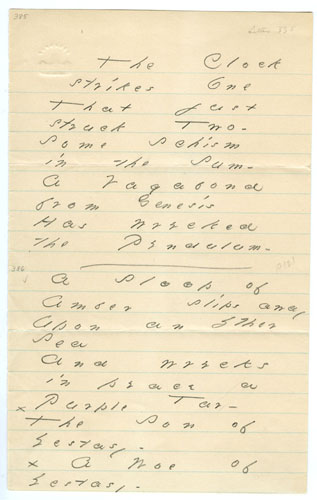
Focus 16: 386. About 1883 or 1884? Lines penciled on a leaf (202 x 126 mm) of wove, off-white, blue-ruled stationery embossed CONGRESS above a capitol.
Inside this poem a fragment is secreted, sealed into it like a light. Even without knowing in advance that it is there, close reading quite often uncovers it. For the fragment is the flashpoint of the text's beginning, a "quickening word" that comes unbidden and that turns our thinking inside out. Among Dickinson's remains, on a scrap of brown wrapping paper, we find this excruciating offering:
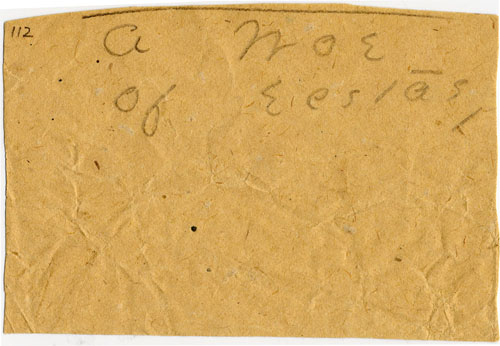
Focus 17: A 112. About 1883 or 1884? Lines penciled on a scrap (60 x 96 mm) of brown wrapping paper.
In this instance the fragment exists in two textual spaces at once: in the poem-message as a variant or rhyming trace of its final line and as an autonomous lyric throe not jettisoned once the poem is finished but translated into another economy altogether. To be sure something is negotiated between the fragment and the poem held spellbound together for an instant—not least of all the poem's boundaries. But, unlike the lists of variants that stream after so many of Dickinson's poems of the 1860s, this fragment is neither visually nor syntactically subordinated to the poem proper. On the contrary, "A Woe | of Ecstasy" rhymes with its variant and reenters the drive of writing—a "presence after presentness." ✝ George Steiner, Real Presences (Chicago: U of Chicago P, 1989), 147. Only the barest signs of a struggle remain—three dashes rend the text at the points where the fragment migrates into the poem and then disengages from it again, while along the top edge a light horizontal line, like the lines Dickinson sometimes drew to separate the body of a poem from its variants and, later, to divide tiny increments of thought, is a graphic sign that these lines were once the last lines of a poem since torn away. Now the "end," the variant, has become a new beginning. Outside the labor of the poem's argument, alone again, the fragment seeks the exact conditions for poetry and becomes pure potential; moreover, by reversing the conditions of inwardness, it extends, exponentially, the original impetus of both poem and oeuvre toward nonclosure.
A trope, or turn, "A Woe | of Ecstasy" does not so much orient the poem in which it appears as a citation as illuminate the inner contradictoriness—the paradoxes, the antinomies—out of which (Dickinson's) poetry is engendered. Again and again, fragments and their traces, like opposing poles, pull away from each other.

Focus 18: A 95-12. About 1871? Poem (unbound) composed in ink on two leaves (203 x 125 mm, leaf) of laid, off-white, blue-ruled stationery embossed FLOWERS (?).

Focus 19: A 352. About 1871? Lines penciled on a fragment (top: 239 mm; left: 131 mm; right: 131 mm) of manila envelope seal.
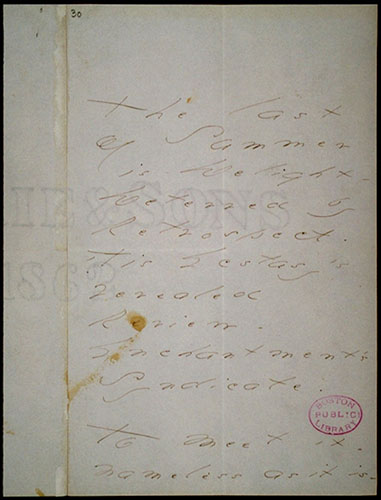
Focus 20: BPL Higg 30. About 1876? Poem (enclosed in a letter to TWH, mailed) composed in ink on two leaves (200 x 130 mm, leaf) of wove, white stationery embossed A PIRIE & SONS 1862.
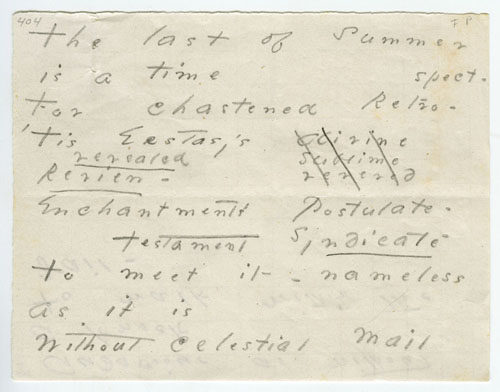
Focus 21: A 404. About 1876? Poem (unbound) composed in pencil on a fragment (92 x 119 mm) of quadrille stationery. A 404 was probably pinned to A 405.

Focus 22: A 405. About 1875 or 1876? Poem (unbound) composed in pencil on a fragment (18 x 127 mm) of wove, white stationery. A 405 was probably pinned to A 404.

Focus 23: A 296. About 1875 or 1876? Lines penciled on a fragment (29 x 128 mm) of quadrille stationery.
And the poem, constituted out of such fragments, arrow-texts aimed in different directions, must perforce break apart again, if only to demonstrate that it, too, is only an excerpt, a citation from a text without beginning or end, a thought subject to be thought again and again.
Thus, in 1877, after "finishing" the poem "After all | Birds have | been investigated | and laid aside" and copying it onto a sheet of embossed stationery, Dickinson suddenly began to unwork it, to write it apart. First, she jotted down a variant for the second stanza; later, the line/thought contracted still further:

Focus 24: A 255. About 1877? Lines penciled amid pen tests on a scrap (30 x 94 mm) of wove, white stationery.
Similarly, in 1874, approximately ten years after making a fair-copy of "A Drop fell on the | Apple Tree -" and three years after completing a fair-copy of "'Remember me' | implored the Thief!" Dickinson suddenly scribbled down two fragments from these poems on the back of an envelope: "Myself compu- | ted were they | Pearls | What Legacy | could be" and "Oh Magnanimity - | My Visitor in | Paradise."

Focus 25: A 313 / 314. About 1873 or 1874? Lines penciled on the inside of an emboss-ruled envelope (73 x 131 mm) addressed, in brown ink, to: "Mrs. Holland -."
Why did she suddenly remember (differently) a few lines from two poems written years apart and dash them down, together? At what instant did two increments of thought, never before linked, suddenly appear on the same empty horizon, drawing two fragments—and thus also two poems—into relation? And why, after a decade, were the poems turned back into fragments, arrow-texts, shot, as Blake writes, into the "airy way"?
Although the random and ephemeral thoughts Dickinson scribbled down on pieces of paper during the final decade of her life have long since turned into printed words, these late fragments remain undomesticatable: they cannot simply be contained in appendices or, as in the case of the trace-fragments, annexed to the more familiar world of the "finished" compositions in which they are held, spellbound, for a moment. Incised not only into Dickinson's poems but also into her letters, which, particularly at the end of her life, are less clearly "fine and private" messages addressed to single, identifiable recipients than accounts of her sudden encounters with awe, fragments, like quotations of other voices, continually set these texts adrift in other, more unpredictable directions. ✝ According to David Higgins, "It was only after her father's death in 1874 that the several variant styles began to approach a single manner. In her last years only a few of her most intimate correspondents . . . received letters distinctly separate from a general style"; see A Portrait of Emily Dickinson: A Poet and Her Prose (New Brunswick: Rutgers UP, 1967), 12. In successive drafts of her final—missing—letter to Helen Hunt Jackson, for instance, in the midst of composition in 1885, three discrete fragments, one on a torn fragment of stationery, another on two fragments of envelope held together with a straight pin, and a third on a torn piece of paper bag attached to a narrow strip of white wrapping paper with a pin, are at first carefully transported into messages continually shifting between "prose" and "poetry."
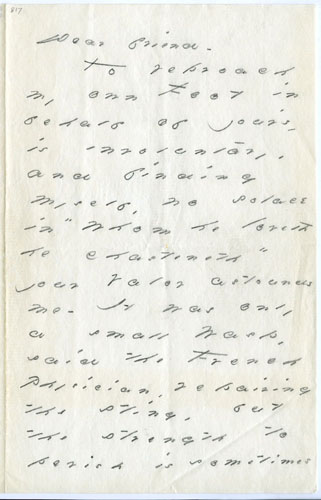
Focus 26: A 817. March 1885. Letter-draft (to Helen Hunt Jackson, incomplete, not mailed) composed in pencil on four leaves (205 x 132 mm, leaf) of laid, off-white stationery embossed Pure Irish Linen F. H. D. & Co. and impressed with a crown.
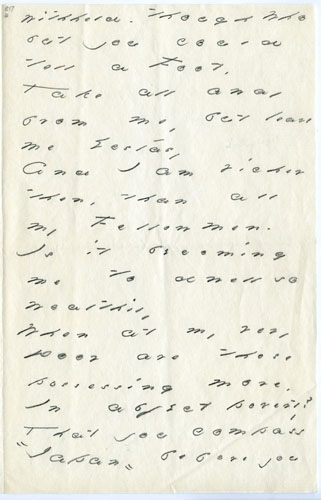
Focus 26a: A 817a
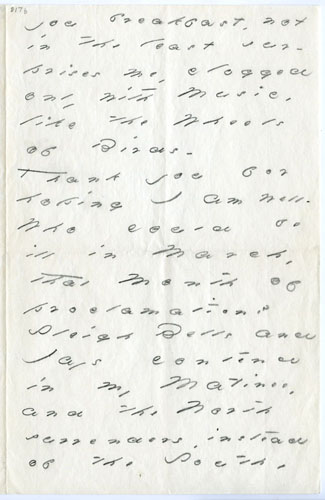
Focus 26b: A 817b
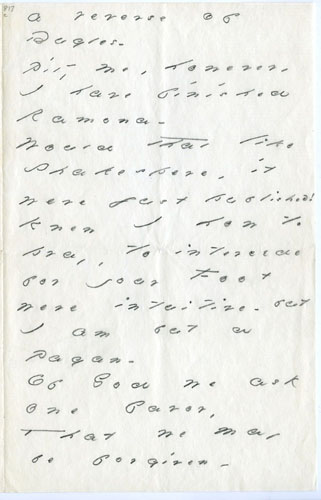
Focus 26c: A 817c
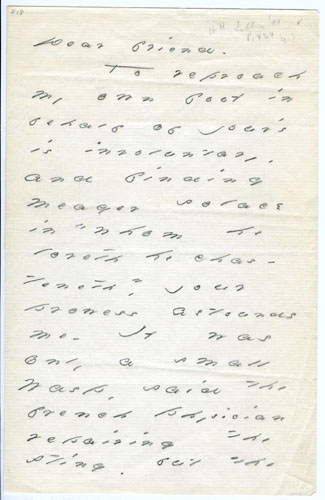
Focus 27: A 818. March 1885. Letter-draft (to Helen Hunt Jackson, incomplete, not mailed) composed in pencil on one leaf (205 x 132 mm) and two fragments (A 818a: 45 x 132 mm; A 818b: 132 x 76 mm) of laid, off-white stationery embossed Pure Irish Linen F. H. D. & Co. and impressed with a crown.
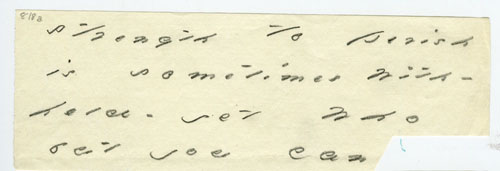
Focus 27a: A 818a

Focus 27b: A 818b
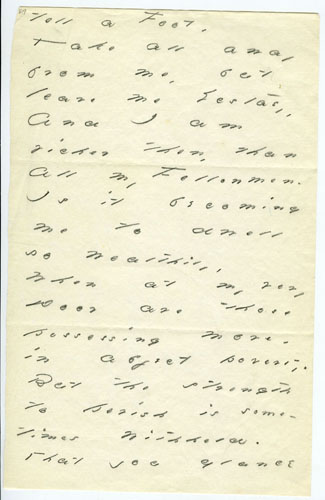
Focus 28: A 819. March 1885. Letter-draft (to Helen Hunt Jackson, incomplete, not mailed) composed in pencil on four leaves (205 x 132, leaf) of laid, off-white stationery embossed Pure Irish Linen F. H. D. & Co. and impressed with a crown.

Focus 28a: A 819a
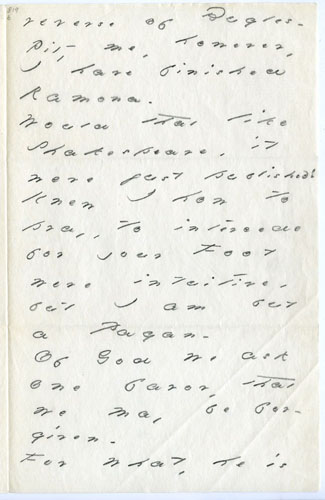
Focus 28b: A 819b
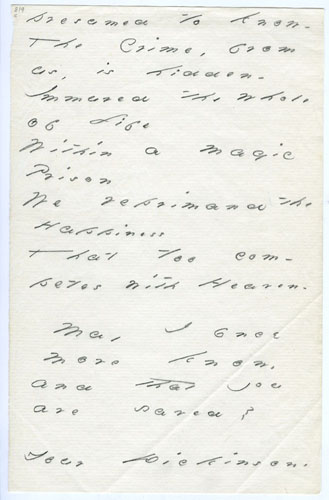
Focus 28c: A 819c
Yet within the interstices of the drafts that seem to repatriate and master them, the fragments continue to mark the place where the amanuensis comes, slipping between registers in a voice at once immediate and alien, writing the text apart. Never simply in league with the letter proper or with the intentions of the letter-writer toward the recipient, they will (have always already) "let go" of the text proper, liquidating their connections with both text and interlocutor in order to acquire additional freedom. The poem-message or letter, ignited by such instants of pure departure, may at any moment revolt against the sovereignty of singular address, taking off from the startled recipient in another direction.
Like the migrating birds, the signs of felicitous defection, are everywhere—

Focus 29: A 820. About 1885? Lines penciled on a torn scrap (100 x 41 mm) of wove, white stationery.

Focus 30: A 822. About 1885? Lines penciled on two scraps of paper—a narrow strip of off-white wrapping paper (161 x 106 mm) and a brown bag (30 x 167 mm)—held together with a straight pin.

Focus 30a: A 822v
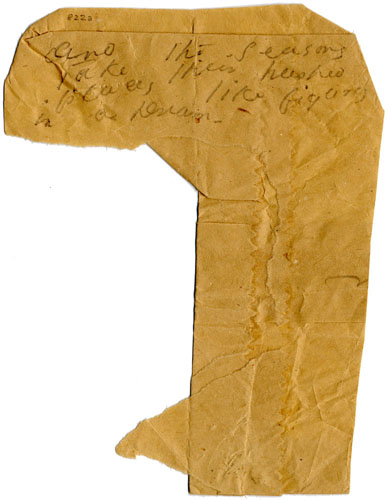
Focus 30b: A 822a
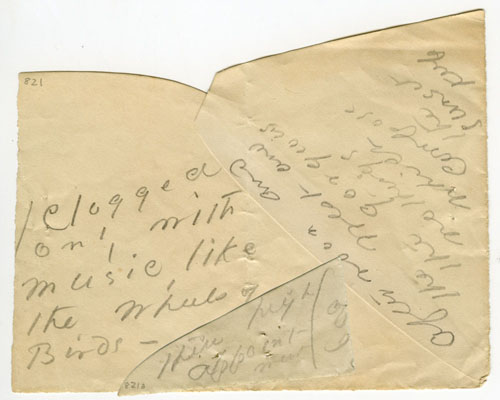
Focus 31: A 821. About 1885? Lines penciled on two scraps of envelope (102 x 127 mm; 31 x 64 mm) held together with a straight pin.
The instantaneous translation from one condition into another radically different one defines the experience of Dickinson's late, ecstatic writings. At last poems (or letters) seem to "rub their eyes" before the fragments as before something too luminous or something moving at too dazzling a velocity. For, like the reader, poems and letters belong to the "posthistory of suddenness," while fragments, variants of the instant of aesthetic appearance, embody the very structure of suddenness. ✝ For a provocative discussion of "suddenness," see Karl Heinz Bohrer, Suddenness: On the Moment of Aesthetic Appearance, translated by Ruth Crowley (New York: Columbia UP, 1994). Their textual status as "fugitives" or "exceptions" is related not only to their insusceptibility to categorization but, paradoxically, to their migration between radically different texts and, finally, to their capacity to survive outside the texts that host them and beyond, too, the mind of the author and her system of intentions. Five sets of pinholes along the left, right, and bottom edges of A 821 attest to the frequency of such textual migrations. Pinning and unpinning fragments, Dickinson continually divined new poems; reckless with final energies, she accompanied them as far as she could.
In the end the exceptions, the fragments, may reveal more than the rule about the state of Dickinson's art. Located at the outermost limits of her work, in the unfamiliar and largely unprobed region of the document, they illuminate the requirements of her aesthetics of radical inquiry and attest to the possibility of a thought no longer guaranteed by unity. Dickinson's final style is thus the style of transition itself. The stunning range of formal and expressive problems she explored in the 1860s, and which can be studied through a close reading of the manuscript volumes, were not in the end resolvable. Most important, as Susan Howe, Sharon Cameron, and others have observed, Dickinson was unable to resolve the problem of variant readings. ✝ See, for example, Susan Howe, "These Flames and Generosities of the Heart: Dickinson and the Illogic of Sumptuary Values," Sulfur 28 (1991): 134–55; and Sharon Cameron, Choosing Not Choosing: Dickinson's Fascicles (Chicago: U of Chicago P, 1992). At first she may have thought to contain not only poems but variants by binding them into manuscript volumes. Later, when the variants threatened to carry both poems and manuscript volumes away, she returned to the single page. The sets, composed in the wake of the manuscript volumes, show Dickinson working on single sheets of stationery, to which she occasionally pinned slips of paper containing overflow lines or variants. Finally, in the 1870s and 1880s the variants and breakaway lines successfully sued for their autonomy. The often violent contest played out in the manuscript volumes between a line (a word) and its alternate is at last eased by Dickinson's decision to make all parties—poem or letter, fragment and variant—equally autonomous, equally transient. Rather then resolve the issue of variation, then, perhaps the central formal issue of her work, Dickinson carries it to extremes, at last choosing to exit the work in order to enter a language of pure risk. Sifting through the manuscripts of these fragments and drafts, the reader receives a profound intimation of the freedom and joy of that final scene of writing. Having abandoned the institution of "authorship" early on in her writing life, Dickinson was able to set in motion a work without beginning or ending. The abbreviation of the late style (thought) must not blind us to the profligate gesture behind it. The fragments—the work in throes—scatter it in all directions at once.
Everything must be redefined in their wake.